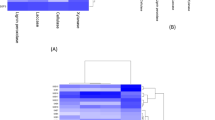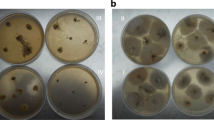Abstract
Brazilian biomes are important sources for environmental microorganisms, including efficient metabolic machineries, like actinomycetes. These bacteria are known for their abilities to produce many bioactive compounds, including enzymes with multiple industrial applications. The present work aimed to evaluate lignocellulolytic abilities of actinomycetes isolated from soil and rhizosphere samples collected at Caatinga, Atlantic and Amazon Forest. Laccase (Lac), lignin peroxidase (LiP), manganese peroxidase (MnP) and cellulase were evaluated for their efficiency. These enzymes have an essential role in lignin decomposition, through oxidation of phenolic and non-phenolic compounds, as well as enzymatic hydrolysis of vegetal biomass. In this sense, a total of 173 actinomycetes were investigated. Eleven (11) of them were selected by their enzymatic performance. The actinomycete AC166 displayed some activity in all analysed scenarios in terms of Lac, MnP and LiP activity, while AC171 was selected as the most promising strain, showing the following activities: 29.7 U.L−1 for Lac; 2.5 U.L−1 for LiP and 23 U.L−1 for MnP. Cellulolytic activities were evaluated at two pH conditions, 4.8 and 7.4, obtaining the following results: 25 U.L−1 and 71 U.L−1, respectively. Thermostability (4, 30 and 60 o C) and salinity concentrations (0 to 4 M) and pH variation (2.0 to 9.0) stabilities of the obtained LiP and Lac enzymatic extracts were also verified. The actinomycete strain AC171 displayed an adaptable response in distinct pH and salt profiles, indicating that bacterial LiP was some halophilic type. Additionally, the strain AC149 produced an alkali and extreme halophilic lignin peroxidase, which are promising profiles for their future application under lignocellulosic biomass at bioethanol biorefineries.










Similar content being viewed by others
Data availability
The data that support the findings of this study are available on request from the corresponding author.
References
Ademakinwa AN, Agboola FK (2016) Biochemical characterization and kinetic studies on a purified yellow laccase from newly isolated Aureobasidium pullulans NAC8 obtained from soil containing decayed plant matter. J Genet Eng Biotechnol. https://doi.org/10.1016/j.jgeb.2016.05.004
Arora DS, Gill PK (2001) Comparison of two assay procedures for lignin peroxidase. Enzyme Microb Technol. https://doi.org/10.1016/S0141-0229(01)00302-7
Baborová P, Möder M, Baldrian P, Cajthamlová C, Cajthaml T (2006) Purification of a new manganese peroxidase of the white-rot fungus Irpex lacteus, and degradation of polycyclic aromatic hydrocarbons by the enzyme. Res Microbiol. https://doi.org/10.1016/j.resmic.2005.09.001
Casciello C, Tonin F, Berini F, Fasoli E, Marinelli F, Pollegioni L, Rosini E (2017) A valuable peroxidase activity from the novel species Nonomuraea gerenzanensis growing on alkali lignin. Biotechnol Rep (amsterdam, Netherlands) 13:49–57. https://doi.org/10.1016/j.btre.2016.12.005
Chaudhary HS, Soni B, Shrivastava AR, Shrivastava S (2013) Diversity and versatility of actinomycetes and its role in antibiotic production. J Appl Pharm Sci. https://doi.org/10.7324/JAPS.2013.38.S14
Coward-Kelly G, Aiello-Mazzari C, Kim S, Granda C, Holtzapple M (2003) Suggested improvements to the standard filter paper assay used to measure cellulase activity. Biotechnol Bioeng. https://doi.org/10.1002/bit.10620
Culaba AB, Mayol AP, San Juan JL, Vinoya CL, Concepcion RS II, Bandala AA, Vicerra RR, Ubando AT, Chen WH, Chang JS (2022) Smart sustainable biorefineries for lignocellulosic biomass. Bioresourc Technol 344:126215. https://doi.org/10.1016/j.biortech.2021.126215
da Cruz Ramos GF, Ramos PL, Passarini MRZ, Silveira MAV, Okamoto DN, de Oliveira LCG, de Vasconcellos SP (2016) Cellulolytic and proteolytic ability of bacteria isolated from gastrointestinal tract and composting of a hippopotamus. AMB Express 6:17. https://doi.org/10.1186/s13568-016-0188-x
Datta R, Kelkar A, Baraniya D, Molaei A, Moulick A, Meena RS, Formanek P (2017) Enzymatic degradation of lignin in Soil: A Review. Sustainability 9:1163. https://doi.org/10.3390/su9071163
De Pinto MC, Ros BA (1996) Inhibition of both peroxidase and laccase by desferal (desferrioxamine mesylate). Phytochemistry. https://doi.org/10.1016/0031-9422(95)00984-1
de Souza Lopes L, Vieira N, da Luz JMR, da Silva MDCS, Cardoso WS, Kasuya MCM (2020) Production of fungal enzymes in Macaúba coconut and enzymatic degradation of textile dye. Biocatal Agric Biotechnol 26:101651. https://doi.org/10.1016/j.bcab.2020.101651
Deguchi T, Kitaoka Y, Kakezawa M, Nishida T (1998) Purification and characterization of a nylon-degrading enzyme. Appl Environ Microbiol. https://doi.org/10.1128/aem.64.4.1366-1371.1998
Dunoyer AT, Cuello REG, Salinas RP (2020) Biodegradation of dairy wastes using crude enzymatic extract of Yarrowia lipolytica ATCC 9773. Rev Ambient Água 15(1):1
Fernández-Fueyo E, Ruiz-Dueñas FJ, Miki Y, Martínez MJ, Hammel KE, Martínez AT (2012) Lignin-degrading peroxidases from genome of selective ligninolytic fungus Ceriporiopsis subvermispora. J Biol Chem. https://doi.org/10.1074/jbc.M112.356378
Ghodake GS, Kalme SD, Jadhav JP, Govindwar SP (2009) Purification and partial characterization of lignin peroxidase from Acinetobacter calcoaceticus NCIM 2890 and its application in decolorization of textile dyes. Appl Biochem Biotechnol. https://doi.org/10.1007/s12010-008-8258-4
Glenn JK, Gold MH (1985) Purification and characterization of an extracellular Mn(II)-dependent peroxidase from the lignin-degrading basidiomycete. Phanerochaete Chrysosporium Arch Biochem Biophys. https://doi.org/10.1016/0003-9861(85)90217-6
Jahangeer S, Khan N, Jahangeer S, Sohail M, Shahzad S, Ahmad A, Khan SA (2005) Screening and characterization of fungal cellulases isolated from the native environmental source. Pak J Bot 37(3):739
Kathiresan K (2020) Biotechnological utilization of mangrove resources. In: Patra JK, Mishra RR (eds) Bioprospecting Potential of Mangrove Resources. Academic Press
Bikash K, Bhardwaj N, Agrawal K, Chaturvedi V, Verma P (2020) Current perspective on pretreatment technologies using lignocellulosic biomass: an emerging biorefinery concept. Fuel Process Technol 199:106244. https://doi.org/10.1016/j.fuproc.2019.106244. (ISSN 0378-3820)
Kuwahara M, Glenn JK, Morgan MA, Gold MH (1984) Separation and characterization of two extracelluar H2O2-dependent oxidases from ligninolytic cultures of Phanerochaete chrysosporium. FEBS Lett. https://doi.org/10.1016/0014-5793(84)80327-0
Lacerda Júnior GV, Noronha MF, de Sousa STP, Cabral L, Domingos DF, Sáber ML, Soares IM, Oliveira VM (2016) Potential of semiarid soil from Caatinga biome as a novel source for mining lignocellulose-degrading enzymes. FEMS Microbiol Ecol. https://doi.org/10.1093/femsec/fiw248
Le Roes-Hill M, Rohland J, Burton S (2011) Actinobacteria isolated from termite guts as a source of novel oxidative enzymes. Antonie Van Leeuwenhoek 100:589–605. https://doi.org/10.1007/s10482-011-9614-x
Mafa MS, Pletschke BI, Malgas S (2021) Defining the frontiers of synergism between cellulolytic enzymes for improved hydrolysis of lignocellulosic feedstocks. Catalysts 11(11):1343. https://doi.org/10.3390/catal11111343
Mandels M, Sternberg D (1976) Recent advances in cellulase technology. J Ferment Technol 54:267–286
Martinho V, dos Santos Lima LM, Barros CA, Ferrari VB, Passarini MRZ, Santos LA, Sebastianes FLS, Lacava PT, de Vasconcellos SP (2019) Enzymatic potential and biosurfactant production by endophytic fungi from mangrove forest in Southeastern Brazil. AMB Express 9(1):1–8. https://doi.org/10.1186/s13568-019-0850-1
Matei JC, Soares M, Bonato ACH, de Freitas MPA, Helm CV, Maroldi WV, Magalhães WLE, Haminiuk CWI, Maciel GM (2020) Enzymatic delignification of sugar cane bagasse and rice husks and its effect in saccharification. Renew Energy 157:987–997. https://doi.org/10.1016/j.renene.2020.05.028
Mayanglambam CS, Singh AK, Singh S, Ngathem TC, Lukram S, Yengkhom DS, Mohanty J, Angami T, Ashok C (2020) Enzymes from mangrove endophytes and their biotechnological/industrial applications. In: Patra JK et al (eds) Biotechnological Utilization of Mangrove Resources. Academic Press
McFarlane HE et al (2014) The cell biology of cellulose synthesis. Annu Rev Plant Biol 65(1):69–94
More SS, Renuka PS, Pruthvi K, Swetha M, Malini S, Veena SM (2011) Isolation, purification, and characterization of fungal Laccase from Pleurotus sp. Enzyme Res. https://doi.org/10.4061/2011/248735
Morozova OV, Shumakovich GP, Gorbacheva MA, Shleev SV, Yaropolov AI (2007) “Blue” laccases. Biochem. https://doi.org/10.1134/S0006297907100112
Niladevi KN, Prema P (2005) Mangrove actinomycetes as the source of ligninolytic enzymes. Actinomycetologica. https://doi.org/10.3209/saj.19.40
Owhe OE, Kumar N, Lynam JG (2021) Lignin extraction from waste biomass with deep eutectic solvents: Molecular weight and heating value. Biocatal Agric Biotechnol 32:101949. https://doi.org/10.1016/j.bcab.2021.101949. (ISSN 1878-8181)
Pollegioni L, Tonin F, Rosini E (2015) Lignin-degrading enzymes. FEBS J. https://doi.org/10.1111/febs.13224
Saini A, Aggarwal NK, Sharma A, Yadav A (2015) Actinomycetes: A Source of Lignocellulolytic Enzymes. Enzyme Res. https://doi.org/10.1155/2015/279381
Saini S, Sharma KK (2021) Fungal lignocellulolytic enzymes and lignocellulose: a critical review on their contribution to multiproduct biorefinery and global biofuel research. Int J Biol Macromol 193:2304–2319. https://doi.org/10.1016/j.ijbiomac.2021.11.063
Saravanakumar K, Rajendran N, Kathiresan K, Chen J (2016) Bioprospects of microbial enzymes from mangrove-associated fungi and bacteria. In: Kim S-K et al (eds) Marine Enzymes Biotechnology Production and Industrial Applications Part II—Marine Organisms Producing Enzymes. Academic Press
Shi K, Liu Y, Chen P, Li Y (2021) Contribution of lignin peroxidase, manganese peroxidase, and laccase in lignite degradation by mixed white-rot fungi. Waste Biomass Valorization 12:3753–3763. https://doi.org/10.1007/s12649-020-01275-z
Silva MLC, de Souza VB, da Silva Santos V, Kamida HM, de Vasconcellos-Neto JRT, Góes-Neto A, Koblitz MGB (2014) Production of manganese peroxidase by trametes villosa on unexpensive substrate and its application in the removal of lignin from agricultural wastes. Adv Biosci Biotechnol. https://doi.org/10.4236/abb.2014.514122
Silveira MAV, dos Santos SM, Okamoto DN, de Melo I, Juliano M, Chagas JR, Vasconcellos SP (2021) Atlantic Forest’s and Caatinga’s semiarid soils and their potential as a source for halothermotolerant actinomycetes and proteolytic enzymes. Environ Technol. https://doi.org/10.1080/09593330.2021.2008015
Su Y, Yu X, Sun Y, Wang G, Chen H, Chen G (2018) Evaluation of Screened Lignin-degrading Fungi for the Biological Pretreatment of Corn Stover. Sci Rep. https://doi.org/10.1038/s41598-018-23626-6
Taketani RG, Moitinho MA, Mauchline TH, Melo IS (2018) Co-occurrence patterns of litter decomposing communities in mangroves indicate a robust community resistant to disturbances. PeerJ 6:e5710–e5710. https://doi.org/10.7717/peerj.5710
Tonin F, Melis R, Cordes A, Sanchez-Amat A, Pollegioni L, Rosini E (2016) Comparison of different microbial laccases as tools for industrial uses. N Biotechnol. https://doi.org/10.1016/j.nbt.2016.01.007
Wong DWS (2009) Structure and action mechanism of ligninolytic enzymes. Appl Biochem Biotechnol 157(2):174–209
Vrsanska M, Voberkova S, Langer V, Palovcikova D, Moulick A, Adam V, Kopel P (2016) Induction of laccase, lignin peroxidase and manganese peroxidase activities in white-rot fungi using copper complexes. Molecules 21(11):1553. https://doi.org/10.3390/molecules21111553
WWF—World Wide Fund to Nature Inc (2022) Amazon. https://www.worldwildlife.org/places/amazon.
Xiao Z, Storms R, Tsang A (2004) Microplate-based filter paper assay to measure total cellulase activity. Biotechnol Bioeng 88:832–837. https://doi.org/10.1002/bit.20286
Yang JS, Yuan HL, Wang HX, Chen WX (2005) Purification and characterization of lignin peroxidases from Penicillium decumbens P6. World J Microbiol Biotechnol. https://doi.org/10.1007/s11274-004-1876-2
Zeng GM, Zhao MH, Huang DL, Lai C, Huang C, Wei Z, Xu P, Li N, Zhang C, Li F, Cheng M (2013) Purification and biochemical characterization of two extracellular peroxidases from Phanerochaete chrysosporium responsible for lignin biodegradation. Int Biodeterior Biodegrad. https://doi.org/10.1016/j.ibiod.2013.07.005
Zhu D, Qaria MA, Zhu B, Sun J, Yang B (2022) Extremophiles and extremozymes in lignin bioprocessing. Renew Sustain Energy Rev 157:112069. https://doi.org/10.1016/j.rser.2021.112069. (ISSN 1364-0321)
Acknowledgements
This study was supported by the Brazilian research agencies FAPESP (Process 2016/23685-7), CAPES (finance code 001) and CNPq (scholarships). The authors would like to register their gratitude to Brazilian Agricultural Research Corporation, EMBRAPA Environment for providing the samples.
Funding
Coordenação de Aperfeiçoamento de Pessoal de Nível Superior,001,001,001,001,001,001,Conselho Nacional de Desenvolvimento Científico e Tecnológico,Fundação de Amparo à Pesquisa do Estado de São Paulo,Brasil,2016/23685-7
Author information
Authors and Affiliations
Contributions
Suzan Pantaroto de Vasconcellos and Debora Noma Okamoto contributed equally to this manuscript. Conceptualization: Debora Noma Okamoto and Suzan Pantaroto de Vasconcellos; Formal analysis: Guilherme Mascalchi de Figueiredo, Mariana Rocha Roswell and Itamar Soares de Melo; Investigation: Kelly Matos Marques, Fernanda Camila Gutierres, Guilherme Gonçalves Guerini, Guilherme Mascalchi de Figueiredo, Vitor Gonçalves Vital, Mariana Rocha Roswell and Itamar Soares de Melo; Methodology: Vitor Baptista Ferrari, Lidiane Maria dos Santos Lima and Marghuel Aparecida Vieira Silveira; Supervision: Suzan Pantaroto de Vasconcellos; Visualisation: Debora Noma Okamoto; Writing – original draft, Vitor Baptista Ferrari, Lidiane Maria dos Santos Lima, Marghuel Aparecida Vieira Silveira, Debora Noma Okamoto and Suzan Pantaroto de Vasconcellos.
Corresponding author
Ethics declarations
Conflict of interest
All authors agree that there are no competing interests for the publication of the present manuscript. Additionally, the authors warrant that this manuscript represents original work that is not being considered for publication in any other vehicle of scientific divulgation. This manuscript does not infringe any other person’s copyright or property rights.
Additional information
Communicated by Yusuf Akhter.
Publisher's Note
Springer Nature remains neutral with regard to jurisdictional claims in published maps and institutional affiliations.
Supplementary Information
Below is the link to the electronic supplementary material.
Rights and permissions
Springer Nature or its licensor (e.g. a society or other partner) holds exclusive rights to this article under a publishing agreement with the author(s) or other rightsholder(s); author self-archiving of the accepted manuscript version of this article is solely governed by the terms of such publishing agreement and applicable law.
About this article
Cite this article
Ferrari, V.B., dos Santos Lima, L.M., de Matos Marques, K. et al. Caatinga, Amazon and Atlantic Forest as natural sources for microbial lignocellulolytic enzymes. Arch Microbiol 206, 161 (2024). https://doi.org/10.1007/s00203-024-03883-y
Received:
Revised:
Accepted:
Published:
DOI: https://doi.org/10.1007/s00203-024-03883-y




